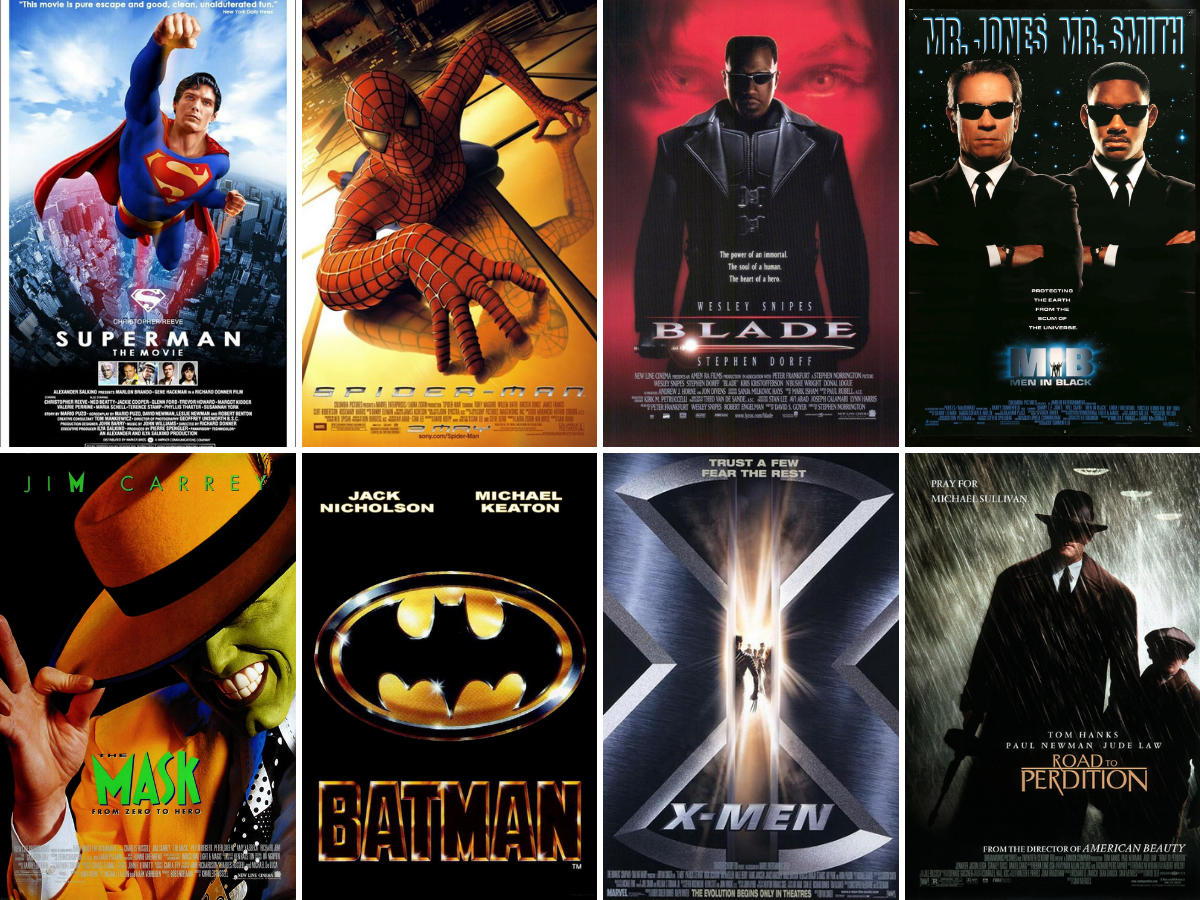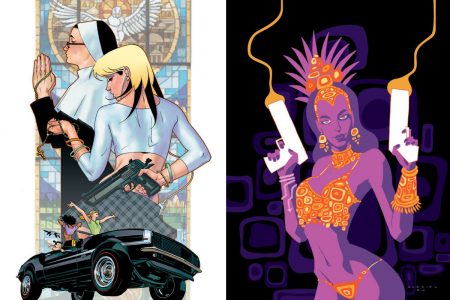(What follows is an article I wrote about comic book movies that I was considering sending out to publications. I never felt very happy about it, so it never saw the light of day. However, I thought I should put it on my blog, as an indicator of my writing ability [or, rather, lack of] and as a historical curio – the last paragraph tells you when it was originally written.)
Comic Books Conquer Hollywood
Spider-Man was a throwaway idea from Stan Lee back in 1961. He knew that Amazing Fantasy, a comic being published by Marvel for whom he was editor, was being cancelled so he decided – on a whim – to put in his story of a young boy who, after being bitten by a radioactive spider, becomes imbued with super human powers. In 2002, Spider-Man, the movie, broke box office records in the United States, grossing over $100 million in its opening weekend. Comic books had become hot property.
The symbiosis between Hollywood and comic books wasn’t always this cosy. Cinema had dipped into the funny books since the early days. Serials of comic strips such as Flash Gordon were mainstays of complete features, and Superman made an early appearance too. However, comics were seen as ‘kid’s stuff’ and were therefore not considered worthy of the industry. In fact, the biggest success for comic books in the mainstream consciousness was on television in the 1960s, when the camp and kitsch Batman aired regularly on Saturday mornings. The series paved the way for the later attempts at turning the serial storytelling of comics into the weekly schedule of television, with adaptations of the The Incredible Hulk, Wonder Woman and Spider-Man. Taking ‘creative’ liberties with the source material (the Hulk has a name change, and becomes a wondering soul, while Spider-Man is bafflingly relocated to Los Angeles, notable for its lack of the skyscrapers that populate the skyline of the original New York), they produced several series and imprinted catchphrases (‘You wouldn’t like me when I’m angry’) and theme tunes (‘Spider-Man, Spider-Man, does whatever a spider can’) on a generation.
It was the original super hero, Superman, however, who led the way into Hollywood and the big time. In 1978, people were told that they would believe a man could fly, and believe they did. The story of Hollywood’s love affair with comics can be seen as the story of technology. This can be seen with Superman, as special effects were reaching a stage where camera trickery could make a man hanging from string look like a superhuman flying gracefully through the air. Comics don’t need special effects to create the same illusion; pencil, paper and imagination are relatively cheap but computers and computer generated imagery require money and a level of sophistication to achieve the same willing suspension of disbelief. Superman spawned three sequels of lessening quality, grounding to a halt after the last one. Batman, in 1989, didn’t require much in the way of special effects, being the story of a man who trains himself to the pinnacle of human condition to avenge the murder of his parents when he was a young boy. Staying fairly true to the comics (even if the fans were aghast when Michael Keaton was cast as their hero), the film exploded into the mainstream, with the film, merchandise and the comic books getting some of the action. Everyone was happy. The second film was decent, but the later Joel Schumacher films, particularly Batman and Robin in 1997, were hugely derided, with the emphasis on set design and paying large salaries to stars to play the pun-spouting villains (cough, Arnold Schwarzenegger, cough) and Batman, and comic book films, were cast aside as quickly as they had been embraced.
There had been other comic book adaptations during these years. Howard the Duck, by George Lucas, was about a talking and singing duck. It didn’t do well, surprisingly. A version of The Punisher with Dolph Lundgren was similarly awful. A Captain America film was made that wasn’t even released theatrically in its home country and there was a Fantastic Four film made by the Corman studio on no budget, which somewhat defeats the purpose. All of these films were adapted from Marvel comic books, who had no idea how to market their properties. Dark Horse, a smaller company, had more success making economically viable films from their books: The Mask, which saw Jim Carrey and Cameron Diaz in early starring roles; Time Cop, with Jean Claude van Damme; Mystery Men, with Ben Stiller and William H. Macy; and Barb Wire, a distaff version of Casablanca, starring Pamela Anderson and her breasts. Another independent book, The Crow, spawned three relatively successful films, although the first one saw the untimely demise of its star, Brandon Lee, son of Bruce. A big success, for an independent comic, was The Teenage Mutant Ninja Turtles, a black and white book, that went on to spawn three silly but successful films; who can forget the sight of four men in turtle costumes doing kung fu, with their giant rat sensei, eating pizza and shouting ‘Cowabunga, dudes’?
Things weren’t good for comic books films in the 90s. Dick Tracy was colourful but slight. Judge Dredd saw Sylvester Stallone take off the famous helmet just to show his face. Spawn was all special effects and no story, while Steel saw the basketball player, Shaq O’Neal, don a ludicrous metal outfit in his bid for stardom. However, in 1997, one of the most successful adaptations was a film that nobody knew had been a comic book. Men in Black was another small independent book transformed into a science fiction comedy that was an almost perfect cinema experience. In 1998, a supporting character from a cult Marvel comic book, Blade, a vampire hunter, became a box office success, capturing the vampire/martial arts zeitgeist. But 2000 saw comic books as a source of potent franchise material. X-Men was a surprise hit but, more importantly, a good film, tackling the themes and characters (if not the garish costumes) of the book and doing it well. Comic book films were cool again, and film studios wanted the rights to make them for themselves.
A scattershot approach followed in the wake of this success, as expected from a place where ‘nobody knows nothing’ according to William Goldman. From Hell is a huge, dense, intelligent piece of work dissecting the mythos behind Jack the Ripper. The film was a ‘cop on the edge’ thriller, with varying degrees of success. The League of Extraordinary Gentlemen was a delightful comic book series, using characters from Victorian fiction. The film was a noisy, brainless, soulless action film which even Sean Connery couldn’t revive. On the other hand, Ghost World was a thoughtful, intelligent and absorbing drama based on the work of Dan Clowes. In the arena of superheroes, Marvel heroes Daredevil and the Hulk made big splashes without overly impressing people in general but it was Spider-Man, a spectacular blockbuster that captures the comic book perfectly while still being a film in its own right, that changed everything for ever. The largest opening weekend of all time told Hollywood that superheroes equal money in the bank. The delays turning Spider-Man into a movie involving legal issues between various studios proved to be fortuitous, as it allowed CGI the time to catch up, enabling the movie makers to have Spider-Man fly through New York landmarks.
The comic book bandwagon kept on rolling. Oscar winner Sam Mendes directed Oscar winners Tom Hanks and Paul Newman in the adaptation of a ‘graphic novel’ (the acceptable term for a big comic book), Road To Perdition, going on to win an Oscar for director of photography Conrad L. Hall. To balance the scales, Bulletproof Monk was a lamentable film about, well, a bulletproof monk, that failed critically and commercially. The sequel to X-Men, X2, was a critical and commercial success, appropriate for the most successful comic book series in the industry. Seemingly, when a film captures the essence of the comic while transferring it successfully to the medium of cinema, the rewards are manifold. When it doesn’t, it deserves the failure.
This year, the sub-genre that is the comic book movie has the Spider-Man sequel, Hellboy, a big-budget version of The Punisher, and Catwoman with Oscar winner Halle Berry. X-Men 3, Blade 3, a new Batman film, a spin-off from Daredevil in the form of Elektra, a big budget Fantastic Four film, Ghost Rider, and Wonder Woman are all in the offing at various stages of production. The future for comic book movies looks bright indeed. There will probably come a time when comic book movies aren’t so eagerly anticipated, and big stars will no longer don spandex in the name of entertainment, which is when they don’t make any money anymore. But, for now, we can enjoy the thrill and excitement in the cinema that the simple format of the comic book has been providing for over 70 years.




